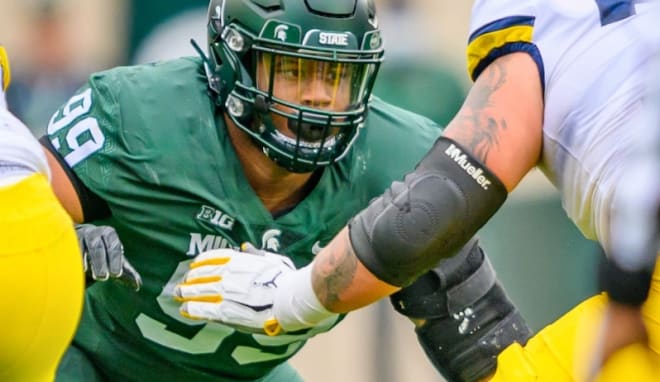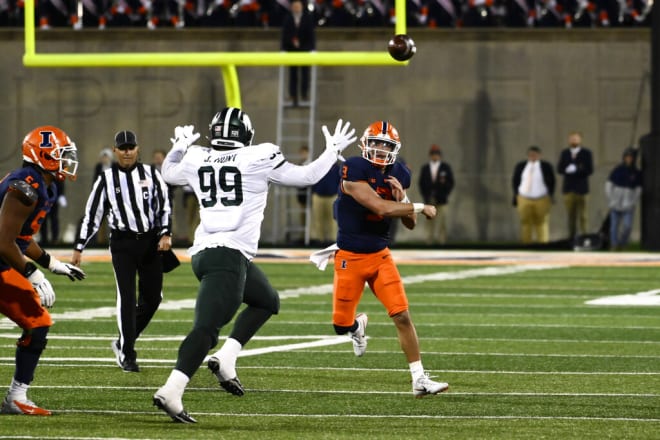Hunt Season: Unlikely move has 'made the fire bigger' for Jalen Hunt

East Lansing, Mich - Jalen Hunt’s 2022 football season changed dramatically, about 10 days ago.
A week ago Monday, Hunt was a seldom-used but promising defensive tackle, trying to return from injury and massive weight loss. He was fighting to regain a spot in the playing group and tap into a vast well of potential.
Then on Tuesday of last week, coaches told him that he was moving to defensive end to help a depth shortage at the position. After a day of practice at defensive end, coaches saw him making progress, and tasked him with an unlikely mission - being the starting defensive end for MSU’s game at Illinois.
By nightfall in Champaign, Ill., on Saturday, Hunt had logged 53 workmanlike snaps against the Illini, helping Michigan State stage an upset of the No. 14-ranked team in the country.
Hunt had only played 31 snaps, combined, in the previous eight games.
“It meant a lot to me,” said Hunt, a redshirt junior from Belleville High School. “Even though I didn’t make many plays, I was still out there with my guys, fighting, in war with them. Most people won’t understand that but sitting out and now being able to play with them means a lot to me in many ways.”
He’s being humble. He made plenty of plays. They might not have ended up in the stat sheet, but he held firm against double-team blocking, set the edge when the play came to his side. He played strong against an Illinois run game that had out-slugged six straight opponents in the trenches.
Hunt helped fill a team need as the Spartans were without injured defensive ends (Jeff Pietrowski and Khris Bogle) and suspended defensive ends (Zion Young and Brandon Wright).
Michigan State used a three-player rotation at the two defensive end positions in Hunt, former defensive tackle Dashaun Mallory and former third-stringer Avery Dunn.
‘WHO IS AVAILABLE?’
Hunt and the makeshift defensive ends helped hold Illinois under its rushing and scoring averages. They played a major role in putting life back into the Spartans’ season.
Michigan State essentially started four defensive tackles at the four defensive line positions.
“As a staff, you have to ask, ‘Okay, who is available and what is the best combination of guys we can put out there?’” said Michigan State head coach Mel Tucker. “Our players are very coachable. They do what we ask them to do.
“We put some bigger guys at defensive end because we were down in numbers. They haven’t had a lot of practice out there, just a couple of days of practice. But B.T. (Brandon Jordan) and Coach (Marco) Coleman did a good job of teaching technique and fundamentals, putting them in position to where we can play good, hard-nosed football.
“We were able to stop the run. There wasn’t going to be a size issue for us. We weren’t going to get knocked off the ball, for sure.”
Size and strength weren’t a problem at defensive end. And perhaps surprisingly, Hunt and Mallory didn’t seem to be at a quickness disadvantage despite their high snap count and heavy payload.
Hunt was quick off the ball and didn’t look slow as a pass rusher.
“I relied on B.T. heavily,” Hunt said. “With me missing spring ball, I didn’t have time to be with him (and work on pass rush). So I ask him as many questions as I can. He has helped me with my footwork and hand placement and eyes.”
Hunt was sidelined for the spring and most of the off-season with shoulder and lower body injuries. He went from 300 pounds to 340.
After he returned to the practice field in August, he gradually began losing weight and regaining quickness and confidence.
“With my weight staff, and our nutrition staff, (team nutritionist) Amber Rinestine has been with me the entire way, helping me out with what to eat and how to grocery shop,” Hunt said. “The weight staff, they have been pushing me to my limits and beyond my limits.
“At that point, it’s all up to me and to push myself. Now I’ve lost all that weight, I can move quicker and faster than I normally would.”
STANDING STRONG
Hunt made an impact on a key play, early in the game at Illinois. After Michigan State threw an interception on its first offensive snap, Illinois quickly drove inside the Michigan State 5-yard line. But the Spartans held firm with a goal line stand, and Hunt played his part.
On third-and-goal from the 3-yard line, Hunt helped stuff a run play by slanting into the C-gap, beting the Illinois tight end to the inside, and making the initial hit on the ball carrier. Linebacker Ben VanSumeren rallied to the ball to assist on the tackle to hold it to a gain of one.
One play later, discouraged by their movement in the run game against MSU’s goal line defense, Illinois went for it on fourth-and-goal at the 2-yard line and threw an incompletion.
The defensive line set the tone, with Hunt making an impact.
“Last week, even though we are missing guys, we still play with a tremendous effort and relentless focus,” Hunt said. “As a team, that kind of brought us closer. On defense, we showed who we really are and what we can possibly do.”
Last year, Hunt played 178 snaps, with an inconsistent role. He started at Northwestern in the season opener, but played only 11 snaps that night. He saw limited action against Indiana and Michigan, although he made a big short-yardage play against the Wolverines in helping Michigan State win on that day.
This from a guy whom former head coach Mark Dantonio said was a budding star when Hunt redshirted in 2019.
In 2020, Hunt started against Indiana, but saw his role decrease as the season progressed, and missed the final two games due to injury.
Hunt came to Michigan State as a 6-foot-2, 262-pound, three-star recruit. With smooth explosiveness for a big man, he starred at d-line and running back for a powerful Belleville High team. A big d-lineman who played high school running back? That’s uncommon, in a good way.
That kind of size, agility and athleticism led SpartanMag.com to call Hunt the most underrated player in the state. He was ranked No. 30 in Michigan, but SpartanMag.com felt he was the type of project who could play at a four-star level in college. And it looked that way through his redshirt year.
But injuries and a flickering level of confidence and perhaps motivation caused Hunt to fall behind a talented cast of defensive tackles at Michigan State, including Jacob Slade, Simeon Barrow, Maverick Hansen and Derrick Harmon.
Despite a limited role, Hunt occasionally flashed major potential. Like the time he two-gapped Penn State’s center, threw him aside and made a tackle on the ball carrier for a huge fourth-down stop, last year in the snow.
“That was one of my favorite plays,” Hunt said. “Making that play alone, I felt, ‘I can do this. I belong. I can do this on the big stage.’”
Off-season procedures to mend injuries, and the reduced practice time, put him in a physical and mental hole.
“I knew I had a lot of work to do personally and mentally to get back,” Hunt said. “Coach Coleman has helped me a lot mentally because it’s hard not being on the field at that time. It was very hard for me as a person but he helped me get along.”
Hunt found a way to compartmentalize his injury rehabilitation.
“I was like, ‘Oh, since I can’t run or anything, this is my time to get my shoulders together.’ And when my shoulder was hurt, I was like, ’It’s time for me to get my lower body together,’” Hunt said. “And when I came back, I was able to get everything together and moving along at the same time at the same speed.”
But he didn’t enjoy a quick return to the playing field. He endured several weeks outside of the playing group.
“I realized I need to lose this weight if I want to be the player I want to be and have the impact I want to have,” Hunt said.
Hunt found motivation at home.
“I’m not just playing for me,” he said. “I’m playing for my family back home because everywhere I go, our name is on my back. I’m carrying us around. With that, I’m also thinking of what’s the Spartans’ best interest. Again, I’m not just representing me, I’m representing my mom, family and Michigan State University.”
He will likely start again on Saturday against Rutgers. In his second week at defensive end, he feels more in tune with the techniques and fundamentals at his new position.
“If you would have asked me two weeks ago, I would have said there isn’t much difference (between d-end and d-tackle),” Hunt said. “But now that I’m actually doing it, there’s a big difference because playing inside is more of an attack mindset; you have to go, go, go. Outside you have to be more patient because things aren’t happening as fast.”
He will move back to defensive tackle at some point, maybe next season. When he returns to d-tackle, he feels he will be a better interior player, having had this experience on the edge.
And the impact of starting against Illinois, and playing down-in and down-out for an improving defense and an improving team as an improving player?
“It makes the fire even bigger,” he said. “It makes it burn more. So now I want to go, go, go.”

